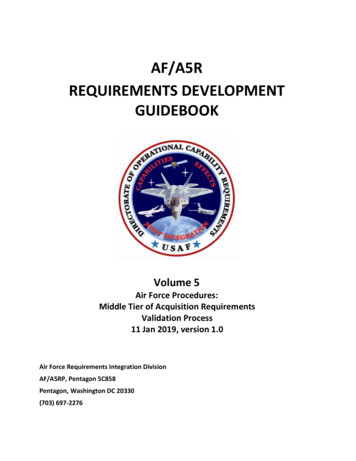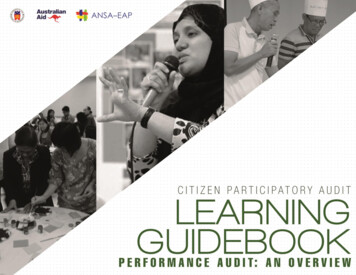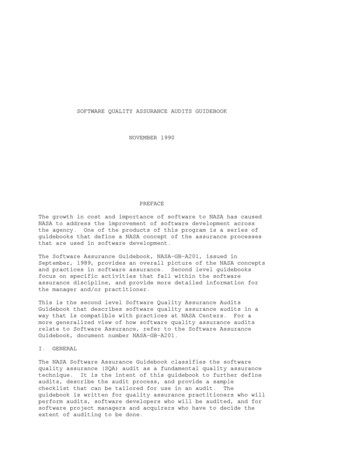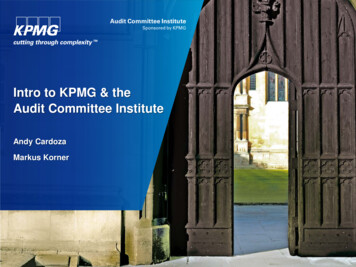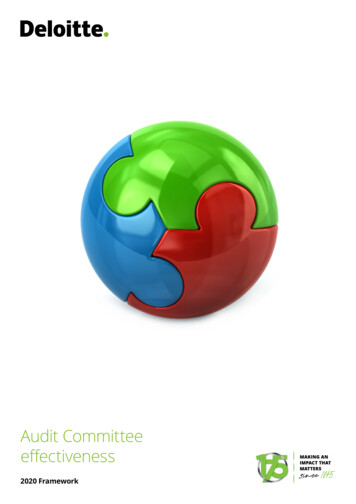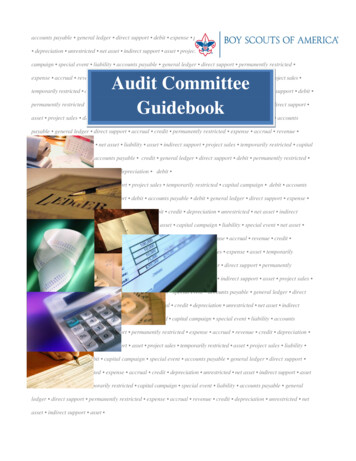
Transcription
accounts payable general ledger direct support debit expense permanently restricted accrual revenue credit depreciation unrestricted net asset indirect support asset project sales debit temporarily restricted capitalcampaign special event liability accounts payable general ledger direct support permanently restricted expense accrual revenue credit depreciation unrestricted net asset indirect support asset project sales Audit CommitteeGuidebooktemporarily restricted asset capital campaign special event accounts payable general ledger direct support debit permanently restricted expense accrual revenue credit depreciation unrestricted net asset indirect support asset project sales debit credit temporarily restricted capital campaign liability special event accountspayable general ledger direct support accrual credit permanently restricted expense accrual revenue depreciation unrestricted net asset liability asset indirect support project sales temporarily restricted capitalcampaign special event accounts payable credit general ledger direct support debit permanently restricted expense accrual revenue credit depreciation debit unrestricted net asset indirect support project sales temporarily restricted capital campaign debit accountspayable general ledger direct support debit accounts payable debit general ledger direct support expense accrual asset permanently restricted revenue debit credit depreciation unrestricted net asset indirectsupport project sales debit temporarily restricted asset capital campaign liability special event net asset accounts payable credit ledger direct support permanently restricted expense accrual revenue credit depreciation unrestricted asset net asset indirect support asset project sales expense asset temporarilyrestricted capital campaign liability debit accounts payable general ledger direct support permanentlyrestricted expense accrual revenue depreciation unrestricted net asset indirect support asset project sales liability temporarily restricted debit capital campaign special event accounts payable general ledger directsupport debit permanently restricted expense accrual credit depreciation unrestricted net asset indirectsupport asset project sales debit temporarily restricted capital campaign special event liability accountspayable general ledger direct support permanently restricted expense accrual revenue credit depreciation unrestricted net asset indirect support asset project sales temporarily restricted asset project sales liability temporarily restricted debit capital campaign special event accounts payable general ledger direct support debit permanently restricted expense accrual credit depreciation unrestricted net asset indirect support asset project sales debit temporarily restricted capital campaign special event liability accounts payable generalledger direct support permanently restricted expense accrual revenue credit depreciation unrestricted netasset indirect support asset
TABLE OF CONTENTSChapter 1. Fiduciary Responsibility and Stewardship . 1-1Chapter 2. The Audit . 2-1Chapter 3. The Audit Committee . 3-1Chapter 4. The Auditor . 4-1Chapter 5. The Auditor’s Report . 5-1APPENDIXA. Sample Not-For-Profit Audit Committee Charter . A-1B. Other Resources Available to the Audit Committee . B-1C. Recommended Audit Committee Meeting Schedule and Timetable for Audit Work . C-1D. Sample Letter of Request for Proposal . D-1E. Representative Questions About Audit Scope and Approach . E-1F. Sample Letter of Engagement From an Independent Auditor . F-1G. Key Items to Look for in an Engagement Letter .G-1H. Representative Questions for Reviewing the Draft Copy of Annual Financial Statements . H-1I.Required Communications . I-1J. The Audit Committee and Internal Control .J-1K. Evaluating the External Auditors: Questions to Consider . K-1L. Sample Independent Auditor’s Reports . L-1M. Audit Committee Chairperson Job Description . M-1
Chapter 1Fiduciary Responsibility and StewardshipFiscal stewardship is a topic of critical importance to councils because it brings into focus several key issues,including fiscal accountability, legal responsibility, regulatory requirements, and delegated responsibility. Firstclass stewardship is expected. Financial difficulties, misuse of funds, and any other stewardship failure canhave an adverse effect on a council’s activities.1.1 Fiscal AccountabilityPublic expectations for fiscal accountability have never been higher. From a legal standpoint, the board of thecouncil is accountable for the property entrusted to its care. Although the board may empower others withmanagerial responsibilities, board members continue to have the primary responsibility for the council’soperational and financial management.1.2 Legal ResponsibilitiesUnder well-established principles of nonprofit corporation law, board members must meet certain standards ofconduct and attention in carrying out their responsibilities to the organization. Several states have statutesadopting some variation of these duties which would be used in court to determine whether a board memberacted improperly. These standards are usually described as the duty of care, the duty of loyalty, and the dutyof obedience (the “three Ds”):1.2.1 Duty of care: Board members are expected to actively participate in organizational planning anddecision making and to make sound and informed judgments.1.2.2 Duty of loyalty: When acting on behalf of the organization, board members must put the interests ofthe nonprofit before any personal or professional concerns and avoid potential conflicts of interest.1.2.3 Duty of obedience: Board members must ensure that the organization complies with all applicablefederal, state, and local laws and regulations, and that it remains committed to its established mission.In addition to its legal responsibilities, the board acts in a fiduciary role by maintaining oversight of thenonprofit's finances. Board members must evaluate financial policies, approve annual budgets, and reviewperiodic financial reports to ensure that the organization has the necessary resources to carry out its missionand remains accountable to its donors and the general public.Board members assume ongoing liability for acts of negligence or willful mismanagement of the council.Because councils solicit money from the public, council personnel and board members may be subjected toclose scrutiny. Council personnel are covered by a fidelity bond. Because council officers and board membersassume a potential of liability, the National Council has developed the Directors and Officers LiabilityInsurance, available to all councils of the Boy Scouts of America.1.3 Regulatory RequirementsThe trend in philanthropy in recent years has moved toward fuller and more accurate disclosure of charitableAudit Committee Guidebook1-1Revised April 2013
organizations’ activities and finances. The giving public is not the only group demanding full disclosure. Manystates have enacted some type of registration requirements for not-for-profit organizations. Included in theserequirements are limits on permitted activities, solicitation disclosures, and financial statement reportingrequirements. Additionally, the federal government requires the filing of information returns, and manymunicipalities have local requirements for fundraising organizations.1.4 Delegated ResponsibilityBoard members and officers rely heavily on the delegation of day-to-day responsibilities to the Scoutexecutive and staff personnel. Therefore, the communication process among these individuals is crucial toensuring sound stewardship.Audit Committee Guidebook1-2Revised April 2013
Chapter 2The AuditAn audit is an examination of the council’s financial statements and the underlying accounting records inaccordance with generally accepted auditing standards, the main objective of which is the expression of anopinion on the fairness of those financial statements. An audit is conducted after each fiscal year or othertimes (e.g., following a council merger or consolidation) as deemed necessary by the executive board.2.1 Policy of the Boy Scouts of AmericaLocal councils have a fiduciary responsibility to contributors. This responsibility mandates a “full disclosure”finance policy to the public. The policy of the Boy Scouts of America is for local council management toannually prepare a set of financial statements for an audit conducted by an independent auditor. Audits mustmeet current requirements set by the American Institute of Certified Public Accountants (AICPA), the BoyScouts of America, and individual state and federal regulatory commissions.From the local council Bylaws template, article X, section 2, clause 6: “A statement of all income andexpenses of the corporation during the fiscal year and a statement of all assets, liabilities, and net assets ofthe corporation as at the end of such year shall be duly audited and certified annually in accordance withgenerally accepted auditing standards, by certified public accountants or other recognized independent publicaccountants approved by the executive board or executive committee.”2.2 Council ActionLocal councils are required to submit to the national office by June 1 each year, audited financial statementsand other documents, including the following (A review or compilation is not acceptable.):A statement of financial position showing all three funds (operating, capital, and endowment) and atotal of all three funds with comparative amounts [or totals] from the previous yearA statement of activities and changes in net assets showing all three funds in the natural or functionalpresentation and a total of all three funds with comparative amounts [or totals] from the previous yearA statement of functional expenses, including total expenses from all three funds and comparativeamounts [or totals] from the previous yearA statement of cash flows for all three funds and a total of all three funds with comparative amounts[or totals] from the previous year (using either the direct or indirect method in arriving at funds fromoperations)Notes to the financial statementsThe independent auditor’s report stating an opinion or disclaimer thereof as to the fair presentation ofthe statementsAudit Committee Guidebook2-1Revised April 2013
The following must be submitted along with the audited financial statements:A copy of the Auditor’s Communication with Those Charged with Governance (SAS 114) letterincluding uncorrected and corrected misstatements (i.e., audit adjustments)Copies of the Communicating Internal Control Related Matters Identified in an Audit (SAS 115) letterand the management response theretoA copy of the management representation letterA copy of the signed audit committee meeting minutes recommending that the audited financialstatements be presented to the executive board for approval including acknowledgement of any BSAdeficiencies noted in the prior year audit and steps taken to correct them in the current yearIn addition, the following must be submitted to the national office when filed. The due date is May 15, but anautomatic three-month extension to file may be obtained by filing Form 8868 by May 15.A copy of IRS Form 990 or 990-EZ and, if filed, IRS Form 990-T for the councilA copy of IRS Form 990 or 990-EZ for council trust fund, if applicableIn an effort to reduce costs and the effect on our environment, all of the above documents may be emailed inportable document format (.pdf) to audits.990@scouting.org. Copies of the annual audited financialstatements and supporting documentation should be maintained at the local council service center in casevolunteers or other interested parties wish to review them.Audit Committee Guidebook2-2Revised April 2013
Chapter 3The Audit CommitteeThe audit committee represents an important resource for the executive board in fulfilling fiduciaryresponsibilities for the finances of the local council. The audit committee is an independent advisory group tothe board. As part of its National Strategic Plan, the BSA required all local councils to adopt, no laterthan December 31, 2011, an audit committee charter that is in compliance with guidelines outlined inthe AICPA Audit Committee Charter Matrix. See Appendix A for sample language that may be used by acouncil in developing an audit committee charter. While the plan has flexibility and may be designed to meetlocal council needs, the role of the audit committee is clear and should not be compromised.3.1 PurposeOne proactive response in the area of accountability is the audit committee. It is being used successfully bypublicly held commercial organizations as well as not-for-profit agencies. Its purpose is to assist the executiveboard in fulfilling the responsibilities related to accounting and financial reporting practices. To effectively fillthis role, the council president must appoint the audit committee as a separate committee that reports to theexecutive board under his direction.The audit committee is not intended to be the “auditor” of the local council. The audit committee is primarilyinterested in compliance with the local council’s policies and procedures, compliance with legal andregulatory requirements, and the presentation of accurate and meaningful financial statements in accordancewith generally accepted accounting principles and the standards set forth by the Boy Scouts of America.3.2 CompositionThe audit committee is generally composed of three to five independent, financially literate individuals, butdoes not include local council officers or professional staff members, who may attend meetings but may notvote. Ideally, members have in-depth business knowledge, familiarity with accounting practices andconcepts, and an interest in helping the council fulfill its fiduciary responsibilities. A majority of the auditcommittee should be members of the local council executive board. Other members should be localcommunity leaders who believe in the benefits derived from an audit committee’s work. Parents of currentScouts, service club members, Eagle Scouts, and members of the local chapter of the state institute of CPAsor the National Association of Accountants are potential audit committee members. No employee of thecouncil’s external auditors should serve on the committee. Audit committee best practice, although not a BSArequirement, is that at least one audit committee member meet the U.S. Securities and ExchangeCommission requirements to be designated as an Audit Committee Financial Expert (as that term is definedby the SEC and summarized below under “Financial Expertise”).3.3 OrganizationThe committee is appointed by and reports to the council board. The Scout executive or assigned staffmember may sit as secretary of the committee, but is not a voting member. The chairperson shall be selectedfrom among those members of the audit committee who are also members of the council executive board.The chairperson should be a respected member of the local council executive board, one who has servedlong enough to provide stability to the committee’s activities and has a proven interest in the fiscalmanagement of the council. The chairperson must work closely with the Scout executive or assigned councilAudit Committee GuidebookRevised April 20133-1
management representative in fulfilling the committee’s responsibilities. See Appendix M for a sample auditcommittee chairperson job description.3.4 Financial ExpertiseThe audit committee should have access to financial expertise, whether in the form of a single individualserving on the committee, who should also be a member of the board of directors, or collectively amongcommittee members.The following attributes are all deemed to be essential components of financial expertise:An understanding of generally accepted accounting principles, generally accepted auditing standards,and financial statementsThe ability to assess the general application of such principles and standards in connection with theaccounting for estimates, accruals, and reservesExperience preparing, auditing, analyzing, or evaluating financial statements that present a breadthand level of complexity of accounting issues that can reasonably be expected to be raised by theorganization’s financial statements, or experience actively supervising (that is, direct involvementwith) one or more persons engaged in such activitiesAn understanding of internal control and procedures for financial reportingAn understanding of audit committee functionsA general understanding of not-for-profit financial issues and specific knowledge of the standards setforth by the Boy Scouts of AmericaThe following questions should be used to assess whether an individual audit committee member, or thecommittee as a whole, possesses the previously stated attributes:Does the individual or the committee as a whole comply with the state’s requirements of auditcommittees regarding independence, expertise, membership, and shared responsibilities with thefinance committee, and so on?Have one or more individuals completed a program of learning in accounting or auditing?Do one or more individuals have experience as a chief or principal financial officer (for example,finance director or business manager), principal accounting officer, controller, public accountant, orauditor?Do one or more individuals have experience in position(s) that involve the performance of similarfunctions?Have one or more individuals gained experience by actively supervising a person(s) performing oneor more of these functions?Do one or more individuals have experience overseeing or assessing the performance of companies,not-for-profit organizations, or public accountants with respect to the preparation, auditing, orevaluation of financial statements? Do one or more individuals have other relevant financialAudit Committee GuidebookRevised April 20133-2
experience (for example, service on boards of banking or investment institutions or experience as abanker or investment adviser)?Do one or more individuals have experience serving on audit committees of other not-for-profitorganizations?3.5 Alternative ApproachesIf no individual member of the audit committee possesses the attributes required for financial expertise andthe committee members collectively do not possess such attributes, several of the following options might beconsidered:If potential volunteers with financial expertise have limited time to commit to an organization, it maybe beneficial, if bylaws allow it, to open up membership of the audit committee to persons who are notalso members of the board of directors or trustees.Establish a relationship with a peer or an otherwise comparable organization to have the CFO for oneorganization provide financial expertise to the other. Such arrangements can be reciprocal or involvemultiple organizations.Establish a relationship with a financial professional who is engaged and compensated to providefinancial expertise as a consultant to the audit committee. Such an individual must otherwise beindependent with respect to the organization (that is, must have no other financial arrangements withthe organization).Pursue a training program for audit committee members to develop the financial expertise. Suchtraining can include participation in professional development programs offered by the AICPA,associations serving the not-for-profit industry, or the conduct of in-house training programs.Refer to Appendix B for resources available to the audit committee.3.6 ResponsibilitiesThe responsibilities of the audit committee include the following:Meet as needed to address matters on its agenda, but not less frequently than twice each year.See Appendix C for a recommended audit committee meeting schedule and timetable for auditwork. Of course, additional meetings should be held to address matters such as possible conflictof-interest situations and to monitor compliance with the council’s code of conduct.Recommend to the board the appointment of the independent auditor to complete the annualaudit of the financial statements of the BSA local council as required by the Standard LocalCouncil Articles of Incorporation and Bylaws. See Appendix D for a sample letter from an auditcommittee member to request a proposal from an independent auditor.Have a planning meeting with the independent auditor and management to review theindependent auditor’s proposed audit scope and approach and approve the auditor’s engagementletter. See Appendix E for representative questions to be used by the audit committee whenreviewing the audit scope and approach. In addition, Appendix F includes a sample letter ofengagement from the independent auditor. Appendix G lists some key items to look for in anAudit Committee GuidebookRevised April 20133-3
engagement letter.Review the independent auditor’s fee arrangements.Have a post-audit meeting to review the draft copy of the financial statements and independentauditor’s report and recommendations on internal control, operating procedures, and suggestionsfor improvements as outlined in the management letter. Review any BSA deficiencies noted inyour prior year’s audited financial statements and steps taken in the current year to correct them.See Appendix H for representative questions for reviewing the draft copy of the annual financialstatements. Also, see Appendix I for a discussion of the management letter and representationletter.Review compliance of the audit with the BSA standards on accounting and adequacy ofmanagement’s policies and procedures on accounting and make recommendations.Review the adequacy of disclosure of information with management.Present the audited financial statements and audit findings to the board following review with theindependent auditor.Periodically review the council’s system of internal control. See Appendix J for a discussion ofhow the audit committee can assist a council in strengthening their internal control system.Review the independent auditor’s performance using the checklist in Appendix K.3.7 New Audit Committee Member OrientationUnderstanding a local council of the Boy Scouts of America—its operations, strategies, risks, culture, andmanagement team—as well as the specific responsibilities that go with audit committee membership, can bea daunting task. That’s why a solid orientation process—including essential briefing materials, discussionswith key people, and a plan for getting up to speed—can greatly accelerate a new audit committee member’sintegration and contribution to the board’s work. To learn more about the “onboarding” process for new localcouncil audit committee members, join hosts Ken Moran, CPA, CGMA, and Coleman Ross, CPA, CMA, CIA,in this recorded webinar by clicking here. Because the presentation has been recorded, you can access itwhenever it is convenient for you.Audit Committee GuidebookRevised April 20133-4
Chapter 4The Auditor4.1 QualificationsThe audit examination should be conducted by an accountant who is both qualified and independent.Regardless of their qualifications, under the AICPA rules, members of the executive board are not consideredindependent, and may not perform the audit even though they may be willing to do so free of charge.As to qualifications, certified public accountants must meet certain educational requirements and pass anexam. Depending on the state, they may also have to meet experience requirements before being certified toperform audits. The requirements to become a public accountant (but not certified) differ from state to stateand are generally less demanding.In choosing an auditor, the council should carefully consider the professional reputation of the prospectiveauditor, regardless of whether or not a certified public accountant is being considered, along with the council’sparticular requirements. Your state’s board of accountancy will be able to tell you if a prospective auditor oraudit firm is properly licensed and in good standing.It is recommended that the council solicit bids for the audit every three to five years or change partners in thecurrent firm every five years.4.2 Overall ObjectivesThe overall objectives of the auditor, in conducting an audit of financial statements, are toa. obtain reasonable assurance about whether the financial statements as a whole are free from materialmisstatement, whether due to fraud or error, thereby enabling the auditor to express an opinion onwhether the financial statements are presented fairly, in all material respects, in accordance with anapplicable financial reporting framework (e.g., generally accepted accounting principles); andb. report on the financial statements, and communicate as required by generally accepted auditingstandards, in accordance with the auditor's findings.In all cases, when reasonable assurance cannot be obtained and a qualified opinion in the auditor's report isinsufficient in the circumstances for purposes of reporting to the intended users of the financial statements,generally accepted auditing standards require that the auditor disclaim an opinion or withdraw from theengagement, when withdrawal is possible under applicable law or regulation.An audit involves performing procedures to obtain audit evidence about the amounts and disclosures in thefinancial statements. The procedures selected depend on the auditor's judgment, including the assessment ofthe risks of material misstatement of the financial statements, whether due to fraud or error. In making thoserisk assessments, the auditor considers internal control relevant to the entity's preparation and fairpresentation of the financial statements in order to design audit procedures that are appropriate in thecircumstances, but not for the purpose of expressing an opinion on the effectiveness of the entity's internalcontrol. An audit also includes evaluating the appropriateness of accounting policies used and theAudit Committee GuidebookRevised April 20134-1
reasonableness of significant accounting estimates made by management, as well as evaluating the overallpresentation of the financial statements.4.3 Clarified Auditing StandardsIn order to make generally accepted auditing standards for nonpublic companies easier to understand andapply, the AICPA's Auditing Standards Board launched its Clarity Project in 2004. Starting with Statement onAuditing Standards (SAS) No. 117 and continuing through SAS No. 127 (clarified and currently effective forlocal council audits), generally accepted auditing standards (GAAS) now more clearly state the objectives ofthe auditor and the requirements with which the auditor has to comply when conducting an audit inaccordance with U.S. GAAS. The Clarity Project will result in the first complete redrafting and recodification ofU.S. GAAS since 1972. In addition to reformatting and reorganizing existing U.S. audit standards, the ClarityProject will integrate them with the International Standards on Auditing. When completed in 2014, clarifiedauditing standards will be issued as one SAS that will replace all prior SASs.The clarified standards introduced many changes to GAAS including terminology used and the form andcontent of the auditor’s report (see Appendix L for sample reports).Audit Committee GuidebookRevised April 20134-2
Chapter 5The Auditor’s Report5.1 New Report FormatAs discussed in the previous chapter, the auditor’s report has changed under the new, clarified auditingstandards and is in effect for local council 2012 audits. The new report format includes the following changes: The introductory paragraph has been shortened to exclude a statement of management’sresponsibility for the financial statements and the auditor’s responsibility under generally acceptedauditing standards in the U.S. It is possible that this paragraph would include a subtitle, Report on theFinancial Statements, if the report also contains a paragraph subtitled Report on Other Legal andRegulatory Requirements, discussed below. Two new paragraphs have been added, each with its own heading: Management’s Responsibility forthe Financial Statements and Auditor’s Responsibility, describing management’s responsibility for thefinancial sta
Audit Committee Guidebook Revised April 2013 Chapter 1 Fiduciary Responsibility and Stewardship Fiscal stewardship is a topic of critical importance to councils because it brings into focus several key issues,


